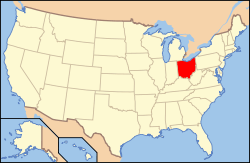Over-the-Rhine
|
Over-the-Rhine Historic District | |
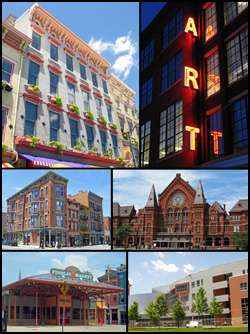 From upper left: Italianate architecture, the Art Academy of Cincinnati, the OTR Gateway Quarter, Music Hall, Findlay Market, and the School for Creative and Performing Arts | |
 | |
| Location | Roughly bounded by Dorsey, Sycamore, Eleanor, Reading, Central Pkwy, McMicken Ave., and Vine streets, Cincinnati, Ohio |
|---|---|
| Coordinates | 39°6′47″N 84°30′58″W / 39.11306°N 84.51611°WCoordinates: 39°6′47″N 84°30′58″W / 39.11306°N 84.51611°W |
| Area | 319 acres (1.29 km2) |
| Architectural style | Greek Revival and Late Victorian[1] |
| NRHP reference # | 83001985[1] |
| Added to NRHP | May 17, 1983[1] |
Over-the-Rhine is a neighborhood in Cincinnati. Historically, Over-the-Rhine has been a working-class neighborhood. It is also believed to be one of the largest, most intact urban historic districts in the United States.[2]
Etymology
The neighborhood's distinctive name comes from its builders and early residents, German immigrants of the mid-19th century. Many walked to work across bridges over the Miami and Erie Canal, which separated the area from downtown Cincinnati. The canal was nicknamed "the Rhine" in reference to the river Rhine in Germany, and the newly settled area north of the canal as "Over the Rhine".[3][4] In German, the district was called über den Rhein.
An early reference to the canal as "the Rhine" appears in the 1853 book White, Red, Black, in which traveler Ferenc Pulszky wrote, "The Germans live all together across the Miami Canal, which is, therefore, here jocosely called the 'Rhine.' "[5] In 1875 writer Daniel J. Kenny referred to the area exclusively as "Over the Rhine." He noted, "Germans and Americans alike love to call the district 'Over the Rhine.' "[6] The canal was drained and capped by Central Parkway, the resulting tunnel was to be used for the now defunct Cincinnati Subway project.
History
Built in the nineteenth century during a period of extensive German immigration, Over-the-Rhine changed as many residents moved to the suburbs following World War 2. The city and area had lost many of the industrial jobs which once supported its workers. By the end of the century, the area was notable for the poverty of remaining residents. In this time period residents united and created many life-saving organizations. The community was strong and accepting.[3]
Geography

Over-the-Rhine is one of the largest, most intact urban historic district in the United States.[2] Because of its size, Over-the-Rhine has several distinct districts. OTR is bisected by Liberty Street. The Northern Liberties[7] and the Brewery District[8] are north of Liberty Street. South of Liberty are the Gateway Quarter and Pendelton.
The Washington Park Area
In recent years developers have renamed this portion of Over-the-Rhine to "The Gateway Quarter". This area has been the focal point of gentrification, which has been controversial due to the displacement of African Americans and low income residents. A comparison of the 2010 and 2000 federal censuses shows that over 1000 African Americans left this area during the decade. As of 2016, this is a primarily white, wealthy and exclusive section of the neighborhood.[9]
The Brewery District
The area north of Liberty street was the heart of Cincinnati's beer brewing industry.[10] Christian Moerlein established his first brewing company in Over-the-Rhine in 1853. Eventually the Christian Moerlein Brewing Co. became the city’s largest brewery and expanded into the national market. At its height the brewery occupied three entire city blocks. Prohibition brought an end to the company in the 1920s.[11] In 2010 the revived Christian Moerlein Brewing Co. began brewing beer in the Brewery District once again.[12]
North of Liberty Street
This area of the neighborhood has been relatively untouched by recent gentrification efforts and may resemble historic OTR better than other areas, though future investment may change this space in the future.[13]
Until 1849, today's Liberty Street, then called Northern Row, was the corporation line forming Cincinnati's northern boundary. The area north of Northern Row was not subject to municipal law and was, appropriately, called 'The Northern Liberties'. In 1955, the city decided to widen Liberty Street to connect with Reading Road as an east-west cross town access point for the interstate highway system. Buildings on the south side of the street were demolished and the street was widened from a two lane road to one with five lanes. Efforts are underway to narrow Liberty Street to bridge the gap between these halves of the neighborhood.[14]
Architecture
Over-the-Rhine has been praised for its collection of historic architecture. The New York Times described the neighborhood as having "a scale and grace reminiscent of Greenwich Village in New York."[15] Its architectural significance has also been compared to the French Quarter in New Orleans and the historic districts of Savannah, Georgia and Charleston, South Carolina.[15][16] When Arthur Frommer, founder of the Frommer's travel guides, visited Over-the-Rhine he described it as the most promising urban area for revitalization in the United States, and claimed that its potential for tourism "literally could rival similar prosperous and heavily visited areas."[17][18]
Most of Over-the-Rhine's ornate brick buildings were built by German immigrants from 1865 to the 1880s.[15] The architecture of Over-the-Rhine reflects the diverse styles of the late nineteenth century—simple vernacular, muted Greek Revival, Italianate and Queen Anne.[19] Most of the buildings in Over-the-Rhine are one of these styles, but there are other odd balls as well. Art Deco is represented by the American Building on Central Parkway, the Germania Building at Twelfth and Walnut streets is ironically one of the few examples of German ornamentation in the neighborhood, Music Hall's mixture of styles is best described as Venetian Gothic, there are a handful of buildings with Gothic architecture, and the new SCPA on Central Parkway is the most notable example of Modern architecture in the neighborhood.[2]
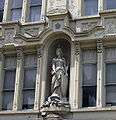 The Germania Building (Eastlake H)
The Germania Building (Eastlake H) Music Hall (Venetian Gothic)
Music Hall (Venetian Gothic)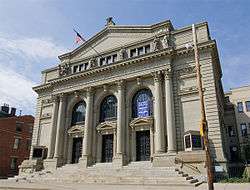 Memorial Hall (Beaux Arts)
Memorial Hall (Beaux Arts) Elaborate ornamentation of an Elm Street building.
Elaborate ornamentation of an Elm Street building. Rounded window cornices are a common feature of Italianate architecture.
Rounded window cornices are a common feature of Italianate architecture. Italianate greystone at Clay and 13th Streets.
Italianate greystone at Clay and 13th Streets. Entrance to the American Building (Art Deco)
Entrance to the American Building (Art Deco) Hanke Building on Main Street detail (Renaissance Revival)
Hanke Building on Main Street detail (Renaissance Revival)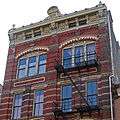 Queen Anne architecture on Main Street
Queen Anne architecture on Main Street
New construction
Noted Indianapolis architect Evans Woollen III and his architectural firm of Woollen, Molzan and Partners were involved in the redevelopment of the historic neighborhood in the 1970s and 1980s. Woollen designed the Over-the-Rhine Pilot Center (1972–84), a group of four modern, mixed-use buildings within a two-block area.[20] The Pilot Center buildings included a recreational center, a senior citizens center, a Montessori school and daycare center, and a meeting and event space. Funding for the $2.5 million project came from the U.S. Department of Housing and Urban Development.[21]
Historic restoration
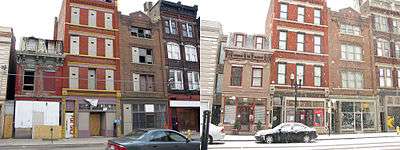
In 2011 the Over-the-Rhine Foundation, which works to prevent historic building loss in OTR, won third place in the National Trust for Historic Preservation's nationwide "This Place Matters" community challenge.[22] In 2006 the National Trust for Historic Preservation listed the status of Over-the-Rhine as "Endangered."[19] Since 1930, approximately half of Over-the-Rhine's historic buildings have been destroyed.[17] More will follow unless currently deteriorating buildings are repaired.[19] Between 2001 and 2006, the city approved more than 50 "emergency demolitions," which were caused by absentee landlords' allowing their buildings to become so critically dilapidated that the city declared them a danger to the public. Reinvestment could have saved them.[17][23] Due to the situation, the National Trust for Historic Preservation declared Over-the-Rhine one of Eleven Most Endangered Historic Places in 2006.[19] Over-the-Rhine was included in the 2008 book, Frommer's 500 Places to See Before They Disappear, which noted the district's "shocking state of neglect".[24]
According to WCPO in 2001, some of the worst-kept properties at the time were owned by Over-the-Rhine's non-profits,[25] which let the buildings sit vacant and deteriorating because of lack of funds[26] or volunteers.[27] With some buildings on the verge of collapse, investors and real-estate developers are trying to restore them before deterioration to the point of requiring demolition.[15] According to the U.S. Census Bureau in 2010, part of Over-the-Rhine had one of the highest rates of abandoned and vacant homes in the country. They classified it then as the sixth hardest area in the nation to get an accurate population count.[28]
In recent years there has been a burst of restoration and development slowly moving northward year by year from Central Parkway, with a focus on attracting local small businesses rather than national chains.[29] Developers have restored and renovated the abandoned buildings, the city renovated nearby Washington Park, and businesses and residents have moved into what were abandoned spaces. Local chefs and artisan brewers in particular embraced the area, and in 2018 Food & Wine Magazine called it "one of the country's most promising food scenes."[30]
Crime
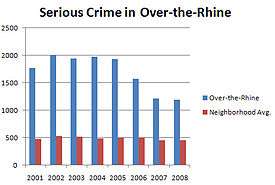
The number of serious crimes committed in OTR has decreased significantly in recent years but still remains significantly higher than the citywide average.
Demographics
| Historical population | ||
|---|---|---|
| Year | Pop. | ±% |
| 1900 | 44,475 | — |
| 1960 | 30,000 | −32.5% |
| 1970 | 15,025 | −49.9% |
| 1980 | 11,914 | −20.7% |
| 1990 | 9,572 | −19.7% |
| 2000 | 7,422 | −22.5% |
| 2007* | 4,970 | −33.0% |
| 2010 | 7,000 | +40.8% |
| *2007 data from Cincinnati Drill Down;[31] 2010 data[32] | ||
In 2001 there were an estimated 500 vacant buildings in Over-the-Rhine with 2,500 residential units.[13] Of those residential units 278 were condemned as uninhabitable.[13] Also in 2001 the owner-occupancy rate was between 3 and 4 percent compared to the citywide rate of 39 percent.[13] According to the "Drilldown", a comprehensive analysis of the city's actual population and demographics conducted in 2007, OTR's current population was just 4,970 people.[33] As of the census[34] of 2000, the racial makeup of Over-the-Rhine was 19.4% White, 76.9% African American, and less than 4% of other races. 0.6% of the population were Hispanics or Latinos of any race.
The neighborhood's residents comprise roughly 1.2% of the population of the City of Cincinnati.
Recent gentrification has changed the demographic makeup of the area as residents moving in tend to be higher income and are more likely to be white.[35] By 2018 the website statisticalatlas.com was estimating OTR's population to be 34% white and 54% black, with 56% of those between the ages of 20 and 24 being white.[36]
In media
- In the movie Ides of March, George Clooney plays a politician who campaigns at Memorial Hall in Over-the-Rhine.
- In the movie Traffic (2000), the teenage daughter of the US drug czar becomes addicted to heroin and goes to Over-the-Rhine for drugs.[37]
- Harry's Law (2011), an NBC legal comedy-drama, is set in Over-the-Rhine, though only old stock photos are shown. No filming was done in Over-the-Rhine or Cincinnati.[38]
- Little Man Tate (1991) was filmed in Over-the-Rhine as well as various other Cincinnati locations.
- A Rage in Harlem (1991) was filmed in Over-the-Rhine because the un-gentrified area resembled 1950s Harlem.[39]
- In Eight Men Out (1988) scenes depicting Chicago in 1919 were shot in Over-the-Rhine.
- Over-the-Rhine and other nearby neighborhoods are featured in the 3 Doors Down music video It's Not My Time.
- In the seriocomic American novel A Deserted Place, by Keith Brabender, the artistic community in Over-the Rhine is featured and contrasted against the religious suburbs of Cincinnati.
- In music, the folk-rock group Over the Rhine took its name from the Cincinnati neighborhood, where the band first started in 1989.[40]
List of annual events
Over-the-Rhine is home to several distinctive annual events. A few of them are:
- Bockfest
- Cincinnati Fringe Festival Annual - Occurs the two weeks after Memorial Day
- MidPoint Music Festival
- Cincinnati May Festival
- Cincinnati Reds Opening Day Parade from Findlay Market to Fountain Square
List of landmarks
Most of Over-the-Rhine's landmarks are related to the arts and are clustered in one area near Downtown.

- Art Academy of Cincinnati, founded in 1869, is a four-year arts college with its campus centered around 12th and Jackson streets.[41]
- Cincinnati Music Hall, built in 1878, is a concert theatre that hosts the Cincinnati Opera, the Cincinnati Symphony Orchestra, the Cincinnati Pops Orchestra, and the Cincinnati May Festival.
- Emery Theatre was built as the original home of the Cincinnati Symphony Orchestra. Famous conductor Leopold Stokowski considered its acoustics comparable to Carnegie Hall.[42][43] It is currently closed for renovations.
- Ensemble Theatre of Cincinnati In Over The Rhine since 1988, a theatre that presents new works and works that are new to the region.
- Findlay Market is the oldest continuously operated public market in Ohio.[44] It is also the site of special events and a farmers' market.[45]
- Know Theatre of Cincinnati a theatre that produces contemporary theatre with new works and regional premeieres. Know Theatre produces the annual Cincinnati Fringe Festival - the largest performing arts festival in Cincinnati.
- Memorial Hall is the home of the Cincinnati Chamber Orchestra, the progressive MusicNow festival, and the American Classical Music Hall of Fame and Museum.
- School for Creative and Performing Arts is the first K-12 selective arts school in the United States.[46] In 2009 the school was the subject of the MTV reality television series Taking the Stage.
- Washington Park, the second oldest park in the city behind Piatt Park, originally established as a burial ground for several small churches.
- Cincinnati Ballet
List of historic churches
- St. Paulus Kirche, 1419 Race Street, German Evangelical Protestant (Oldest Protestant church in the city)
- German Baptist Church, Walnut and Liberty Streets
- Old St. Mary's Church, 123 E. Thirteenth Street
- Philippus United Church of Christ, West Mcmicken and Ohio Avenues
- St. John the Baptist Church, Green and Bremen Streets
- Saint Francis Seraph Church, Vine and Liberty Streets
- St. Paul Church, East 12th and Spring Streets
- Salem United Church of Christ, 1425 Sycamore Street
- Nast Trinity United Methodist Church, 1310 Race Street (Known as Over-the-Rhine Community Methodist Church since 2015)
- Wesley Chapel, 76 E. McMicken Avenue
- Prince of Peace Lutheran Church, 1528 Race Street
- First Lutheran Church, 1208 Race Street
List of community organizations
- Over-the-Rhine Community Housing - Formed in April 2006 by the merger of two organizations supporting affordable housing.
- Drop Inn Center a homeless shelter which offers chemical dependency treatment. Removed from neighborhood October 2015. [47]
- Greater Cincinnati Coalition for the Homeless is an advocacy organization started in 1984 to advocate for people experiencing homelessness, affordable housing, and other solutions to eradicating homelessness.
- Contact Center.
- St. Francis Seraph.
- Mary Magdalen House.
- Imani Community Center.
- Peaslee Neighbhorhood Center.
- Over-the-Rhine Foundation, works to protect OTR's endangered historic structures, preserve its cultural heritage, and promote a physically and socially sustainable neighborhood.
- Brewery District Community Urban Redevelopment Corp. works to develop the northern half of the neighborhood, with an emphasis on OTR's brewing heritage and the mixed-use neighborhood created by use of the nineteenth-century brewery building stock.
- Cincinnati Center City Development Corporation Public funding to rehabilitate and renovate city structures.
- Over-the-Rhine Community Council - Since 1970, the council has represented the interests of residents and partnered with other organizations in service to our neighbors in our unique, historic neighborhood.
- Mercy Health - St. John began as St. John Social Service Center in 1936. Now the agency is a comprehensive social service agency providing: shelter for homeless families, emergency food, emergency financial assistance for rent, mortgage and utility, job training and computer instruction, case management, youth development and health care. (Closed 2015)
- Our Daily Bread[48]
- Wesley Chapel- an after school program for children in the neighborhood
List of notable residents
- Levi Coffin, "President of the Underground Railroad"
- Nick Clooney, journalist and game show host and father of George Clooney
- Ronald Howes, American toy inventor, created the Easy-Bake Oven.[49]
- Venus Ramey, 1944 Miss America winner
- Buddy Gray, community activist
- Anna Marie Hahn, female serial killer
- Chris Seelbach, Cincinnati City Councilman elected in 2011
- Jim Tarbell, Former City Council member and former owner of Arnold's Bar and Grill & Grammers
References[9]
- 1 2 3 National Park Service (2007-06-30). "National Register Information System". National Register of Historic Places. National Park Service.
- 1 2 3 Over-the-Rhine Foundation. Guide to OTR Architecture. Accessed on 2009-08-13.
- 1 2 Over-the-Rhine Foundation. OTR History Archived 2009-05-28 at the Wayback Machine.. Accessed on June 13, 2009
- ↑ Kenny (1875), pg. 130.
- ↑ Pulszky, Francis; Theresa Pulszky (1853). White, Red, Black: Sketches of American Society in the United States. New York: Redfield. p. 297.
- ↑ Kenny (1875), pg. 129.
- ↑ Market History | Findlay Market of Cincinnati, Ohio
- ↑ OTR Brewery District | Cincinnati, OH
- 1 2 Skirtz, Alice (2012). Econocide: Elimination of the Urban Poor. NASW Press. ISBN 978-0-87101-424-5.
- ↑ OTR Brewery District | Cincinnati, OH
- ↑ Over-the-Rhine, Cincinnati, OH - iRhine.com - Brewery District
- ↑ Newberry, Jon (2010-12-17). "Christian Moerlein brews new 'Arnold's' beer in OTR".
- 1 2 3 4 Federal Reserve Bank of Cleveland, Bridging the Economic Divide: Cincinnati's Crisis Presents New Opportunities Archived 2011-07-08 at the Wayback Machine.. Fall 2001. Retrieved on 2009-01-11
- ↑ http://www.urbancincy.com/tag/liberty-street-road-diet/
- 1 2 3 4 MAAG, CHRISTOPHER (November 25, 2006). "In Cincinnati, Life Breathes Anew in Riot-Scarred Area". New York Times.
- ↑ OTR Foundation Why OTR Matters. Accessed on 2010-08-13.
- 1 2 3 Over-the-Rhine Foundation. Historic Preservation. Accessed on 2009-08-13.
- ↑ iRhine.com, Over-the-Rhine History, Part 2. Accessed on 2009-08-13
- 1 2 3 4 National Trust for Historic Preservation, 11 Most Endangered: Over-the-Rhine Neighborhood. Accessed on June 13, 2009.
- ↑ Philip J. Trounstine (May 9, 1976). "Evans Woollen: Struggles of a 'Good Architect'". [Indianapolis] Star Magazine. Indianapolis, Indiana: 23.
- ↑ "Pilot Center Filling in Over-the-Rhine". Architectural Record. New York City: McGrall-Hill. 158 (5): 81. October 1975.
- ↑ "2011 This Place Matters Community Challenge". 2011 This Place Matters Community Challenge. National Trust for Historic Preservation. Retrieved July 20, 2011.
- ↑ "Now, not soon, is the time to save OTR's historic treasures". Cincinnati Enquirer. January 14, 2010. Retrieved February 26, 2010.
- ↑ Hughes, Holly; West, Larry. 500 Places to See Before They Disappear. Frommer's. pp. 346–47. ISBN 0-470-18986-X.
- ↑ Quinlivan (2001) 27:58
- ↑ Quinlivan (2001) 28:30
- ↑ Quinlivan (2001) 12:10
- ↑ "OTR, West End a quagmire for census". Cincinnati Enquirer. March 1, 2010. Retrieved 2010-03-14.
- ↑ Woodard, Colin. "How Cincinnati Salvaged the Nation's Most Dangerous Neighborhood". Politico. Retrieved 14 June 2018.
- ↑ Landsel, David. "This Midwest Neighborhood Is Home to One of the Country's Most Promising Food Scenes". Food and Wine. Retrieved 14 June 2018.
- ↑ http://www.uc.edu/cdc/urban_database/citywide_regional/cinti_drilldown_report.pdf
- ↑ http://news.cincinnati.com/article/AB/20110403/NEWS01/104030305/A-different-struggle
- ↑ "Cincinnati Neighborhood Market DrillDown" (PDF). Social Compact Inc. June 2007. Retrieved 23 December 2011.
- ↑ "American FactFinder". United States Census Bureau. Retrieved 2008-01-31.
- ↑ Swartsell, Nick. "The Ollie's Trolley mural at Liberty and Race streets will come down to make way for building improvements and a new bar". City Beat. Retrieved 14 June 2018.
- ↑ StatisticalAtlas.com https://statisticalatlas.com/neighborhood/Ohio/Cincinnati/Over-The-Rhine/Race-and-Ethnicity. Retrieved 14 June 2018. Missing or empty
|title=(help) - ↑ Over-the-Rhine Film Synopsis
- ↑ Kiesewetter, John (January 17, 2011). "Laying down the 'Harry's Law'" (Press release). WCPO.
- ↑ William Horberg (November 7, 2008). "The Last Chester Himes Movie? pt 2". Typepad. Retrieved 2010-11-05.
- ↑ http://overtherhine.com/story/faq/
- ↑ Art The Academy of Cincinnati. About The Art Academy of Cincinnati Archived 2009-09-04 at the Wayback Machine.. Accessed on 2009-08-23.
- ↑ "$3 Million Projected to Reopen the Emery Theatre" (Press release). Emery Center Corporation. October 29, 2008. Retrieved December 7, 2008.
- ↑ Gelfand, Janelle (August 31, 1999). "Emery fix-up in the wings : Team works to bring 1911 gem into the 21st century". Cincinnati Enquirer. Retrieved July 10, 2008.
- ↑ Findlay Market. About Findlay Market. Accessed on 2009-08-23.
- ↑ Findlay Market-Historic renovated Cincinnati Public Market and Farmers Market Corporation for Findlay Market, 2007. Accessed 27 May 2007.
- ↑ School for Creative and Performing Arts. The New SCPA. Accessed on 2009-08-23.
- ↑ Over the Rhine Community Housing — About Archived 2011-07-25 at the Wayback Machine. Over-the-Rhine Community Housing, Accessed 27 May 2007
- ↑ http://ourdailybread.us
- ↑ Horstman, Barry M. (2010-02-19). "Ronald Howes, inventor of Easy-Bake Oven, dies at 83". Cincinnati Enquirer. Archived from the original on 2010-02-23. Retrieved 2010-03-04.
.png)

